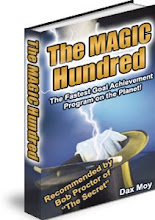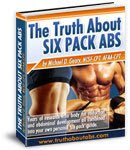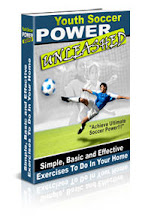Today I have a very special present for you!
I’ve been able to score an interview with Craig Ballantyne of
Turbulence Training fame.
Craig is turning 33 and he’s the one giving you the gifts – he’s got an awesome tie sensitive 3 day promo on right now, but more of that later.
The timing on this is great seeing as I'll be overseas for 3 weeks as of next week. These TT workouts will help you through the 3 weeks i'm away!
http://www.ttworkouts.com/It’s a long one, so I’ve split the interview in 2 and will give you part 2 on Wednesday. So be sure not to miss wednesdays update as Craig will give you his favourite fat loss exercises and his BIG tip on where people are going wrong with their fat loss program.
Anyway, let's get to it!
DPM: Can you please give everyone a background on Turbulence Training and why you created it.
CB: Like most folks in the fitness industry, I played a lot of sports when I was younger. That led to weight training. From there, I realized I wanted to be a strength coach in professional sports.
I went to school for Kinesiology, which then led to a Master's Degree in Exercise Physiology.
Along the way I studied what made a good NHL Strength Coach (they had Master's Degrees and were Certified Strength And Conditioning Specialists - CSCS).
I also started training athletes, along with men and women for fat loss.
In 1998-99, I was but a lowly grad student, studying the effects ofandrostenedione (the supplement taken by the mighty baseball player, Mark McGwire during his record-breaking home run quest in '98).
In my study (which was published in the Canadian Journal of AppliedPhysiology for any science nerds like myself out there), we had guys use the supplement and go through a couple of weight training sessions. By February of '99 I was stuck in the lab, analyzing the blood samples using some fancy radio-active isotopes.
And when I say stuck in the lab, I mean STUCK. I'd get there at 7am, and record my last data point at 11pm. Sixteen hours of mad science. And if I wasn't there, I was downstairs in the medical library, studying papers on testosterone and training.
Now coming from a very athletic background, this sedentary lifestyle didn't sit well with me. But there I was, studying for a degree in Exercise Physiology and left with no time for exercise.
Or so I thought.
Fortunately, I actually had a 50 minute window once per day of "down-time" while the lab's gamma-counter analyzed blood samples.
That left me 50 minutes to get to the gym (5 minutes across campus) and get a workout in the remaining 40 or so minutes. I knew that if I applied my studies to the workout, I could get maximum results in minimum time.
As a former athlete, I knew that I had to find a way to stay fit and to avoid the fat gain that comes with working long hours in a sedentary environment. And I also had to stay true to the high-school bodybuilder I once was, so there was no way I was willing to sacrifice my muscle to one of those long-cardio, low protein fat-loss plans that were popular at the time.
Instead, I had to draw on my academic studies and my experiences working with athletes as the school's Strength & Conditioning Coach.
I knew that sprint intervals were associated with more fat loss than slow cardio, and I knew that you could also increase aerobic fitness by doing sprints (but you can't increase sprint performance by doing aerobic training).
So clearly, intervals were (and ARE!) superior to long slow cardio.
I had seen first hand the incredible results of sprint intervals in the summer and fall, as the athletes made huge fitness improvements and shed winter fat in a short time using my interval programs. I knew that intervals had to be the next step in the evolution of cardio.
The biggest benefit of intervals? A lot of results in a short amount of time. I knew that I only had 40 minutes to train, and therefore I could only spend 15-20 minutes doing intervals.
Now onto the strength training portion of the workouts. I knew that a high-volume bodybuilding program wasn't going to cut it - I just didn't have time. But in the past year I had read so many lifting studies, that I knew exactly what exercises I needed to do to maximize my lifting time in the gym.
Those exercises were standing, multi-muscle, movements such as squats, presses, rows, and plenty of other standing single-leg exercises. I knew that those exercises would bring me far more results than those people sitting on machines would ever achieve.
And I also knew that I had to lift heavier than the average Joe or Jane Gym-goer lifts. I just knew that doing lighter weights and high-reps wasn't going to cut it.
And a research study from 2001 later showed that I was right - when women did 8 reps per set, they had a significantly greater increase in post-workout metabolism than if they did 15 reps per set.
So I had my plan. Bust my tail over to the gym, through the cold, dreary Canadian winter afternoon, and do a quick but thorough warmup (specific to my lifts - none of that 5 minutes on the treadmill waste of time).
Once I got through the warm-up, I did as many sets as I could in the remainder of the 20 minutes for strength training.
At that point, I knew that supersets were the only way to go if I wanted to maximize the number of sets I could do...so the non-competing superset of Turbulence Training was put in place.
By non-competing, I mean that the 2 exercises in the superset don't interfere with one another. So you can use upper and lower body exercises together, or pushing and pulling exercises. Just be careful not to use two grip-intensive exercises together in a superset - otherwise, one exercise will suffer, if not both.
And then I followed up the strength training with intervals, as I knew these had to follow the lifting, otherwise it would not be the correct exercise order. Remember, intervals first leads to premature fatigue. Lift first, cardio later. Forget that old wives tale about doing cardio first to burn more fat. That's junk.
You know, I remember the exact day and exact workout that this all came together into the Turbulence Training program. It hit me as I was finishing my intervals. I knew I had found something that was like fat loss magic.
Unfortunately, I couldn't find a way to put it in a pill. But I've been able to put it down on paper in all of the TT manuals.
DPM: When I look at your members forum I see that it has grown a bit of a cult following hasn't it? Why do you think this has really taken off?
CB: The forum offers social support, so we have members all over the world doing the same workouts, going through similar trials and tribulations, and helping one another out.
It's so interesting to wake-up to hear from Lisa and Johnno down in NZ and Oz sharing their thoughts, and then we here in North America post our workouts and thoughts while they sleep.
And sometimes we overlap, but its just so great to have people doing this all over the world - and helping one another.
And the thing that holds everyone together is the common bond of being busy, of having a stressful job and hectic family life, but the workouts are short and infrequent, so it allows for a regular lifestyle at the same time as actually getting results.
No more hour long cardio sessions everyday with nothing to show for it.
DPM: Let's cut to the chase. What's your number 1 fat loss tip that you can give everyone here?
CB: I wish it was simply, "Use Turbulence Training". But it's not.
The #1 tip everyone must follow to lose fat is to cut out sugar and processed carbohydrates from your diet. Stick to a whole, natural foods diet of vegetables, fruits, nuts, healthy fats, and protein sources.
If it is at all modified from its regular source, then skip it and find something closer to its original form.
I just finished a dinner of steak, mixed vegetables, and avocado (goes great with steak!). That's much better than pasta with tomato sauce.
DPM: On a lighter note, if you were stranded on a desert island, what 3 items would you want to take with you?
CB: My dog. A really, really, really big bag of dog food. And a boat.
DPM: You're running a massive 3 day Birthday Celebration Giveaway (that starts today) for your birthday. Can you tell people what they'll be missing if they miss the boat on this one?
CB: I've called in a bunch of favors, and here are the 10 gifts I'm giving away to celebrate my 33rd birthday...they will help everyone burn belly fat and reach their goals...and maybe even help them win my TT Transformation Contest!
1) Meal Plans for Men & Women by Dr. Chris Mohr (Value $97)
2) Bikini Ready Abs by Holly Rigsby (Value $29.95)
3) 10-Minute Trouble Spot Workout for Women by Joey Atlas (Value = $27)
4) The Abdominal Exercise Index (Value = $77)
5) Kettlebell Fat Burning Workout Unleashed by Troy Anderson (Value = $47)
6) Home Gym Muscle Building Workout by Jay Ferruggia (Value = $79.95)
7) The Big 5 Fat Loss Turbulence Training Circuit Workout by Craig Ballantyne (Value $19.95)
8) TT for Amazing Lower Abs by Craig Ballantyne (Value = $19.95)
9) The Turbulence Training Hardcore Fat Loss 4-Week Program by Craig Ballantyne (Value $19.99)
10) A 3-Month Basic Level Membership to the Turbulence Training Discussion Forums & Other Exclusive Fat Loss Info (Value $119.70)
DPM: CB, thanks for your time mate, I really appreciate you taking the time out to give my readers a bit of an insight into your mind.
Dont forget if you want a piece of Craig’s birthday promotion, check out
http://www.ttworkouts.com/.
You’ve got 3 days then all the extra bonuses will be taken down!
So, what's your excuse?
Fire UP!








